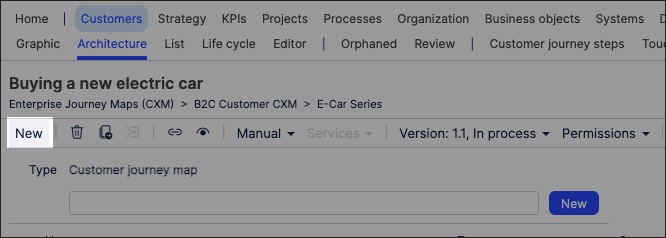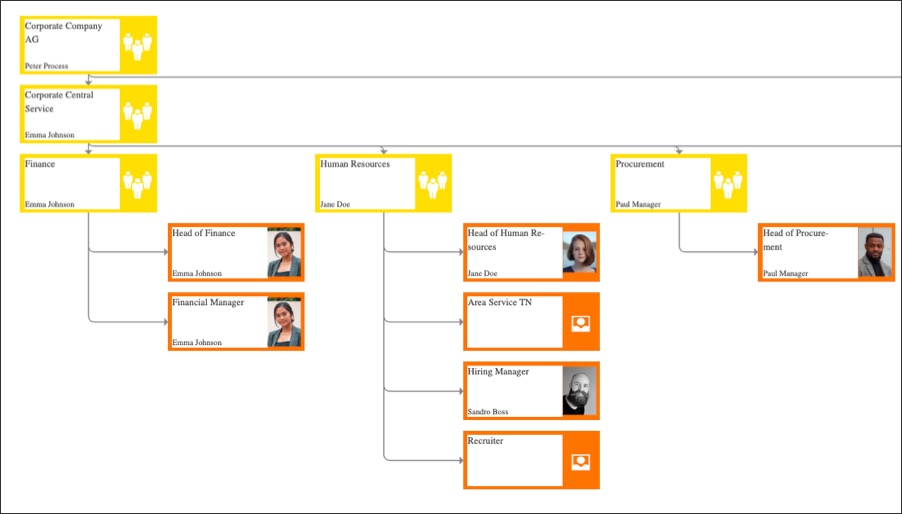Repository objects
In Process Designer, repository objects are the reusable elements that serve as the building blocks for modeling processes, data, roles, systems, and other process components. These are stored in a central repository and can be linked across multiple processes and diagrams to ensure consistency, standardization, and traceability. Related repository objects are grouped together into what's called business facets.
The benefits of creating and using repository objects include:
Re-usability: Define the object once and then use it across multiple processes.
Consistency: Ensure that all your objects have standard naming, attributes, and logic across processes.
Traceability: Understand where and how each object is used.
Governance: Maintain control over who can create or edit objects. Impact analysis: Quickly see the impact of changes across models
Impact analysis: Quickly see the impact of changes across models
Repository objects main features
Each business facet has its own creation and management area that can be accessed from the main navigation:

Within each repository object area, you'll find the same main features. These features include:
You can create repository objects by selecting the Architecture tab and clicking New (if this is not open by default):

The objects you create are then added to the architecture overview, allowing you to edit and delete them when required. You can also use the toolbar for each object:

Many repository objects also have related objects, managed from within the repository object are. For example, within the Organization area you can also create and manage the following repository objects:
Org units
Positions
Skills
Groups
Roles
Locations

Once a related object has been created, it can be managed from both the Architecture tab and within their own sub-area.
For all repository objects, you can create a graphic using the Editor feature. This enables you to visually map out the structure and contents of your organization's content.
In this example, the Editor has been used to create an org chart graphic (as part of the Organization repository object):

In Process Designer, orphaned content refers to elements or objects that exist in the database but are no longer linked to any active process, diagram, or model. These items are essentially "stranded" — they’ve been created or imported but aren’t currently being used or referenced anywhere within the structured process hierarchy.
Examples of orphaned content in might include:
Process steps that are not part of any process flow.
Roles, documents, or IT systems not linked to any process.
Deleted or restructured process elements that were left behind.
Versions of objects that were replaced but not removed.
Within each repository object area, click Orphaned to review these objects.

Available repository objects
The following repository objects are available in Process Designer:
Repository object | Description | Related objects | For more information |
|---|---|---|---|
Business objects | Business objects are reusable data structures that represent key entities or pieces of information within business processes, such as orders, invoices, and products. These objects help model how data flows through the organization and how that data is involved in various tasks, decisions, and interactions. | ||
Customer Experience Manager / Customer journey maps | In Process Designer, Customer Experience Management (CXM or CEM) refers to the structured approach to mapping, analyzing, and optimizing the interactions and touchpoints that customers have with an organization throughout their journey. By mapping your customer journeys, you can integrate the customer perspective directly into process design, ensuring that processes are not only efficient internally but also deliver a positive and consistent customer experience. | Within the Customer area, you can also create and manage the following objects:
| |
Documents | Documents are digital or physical artifacts that are linked to business processes, tasks, or objects. They represent information carriers that support, govern, or result from process activities. | ||
Key Performance Indicators (KPIs) | Key Performance Indicators (KPIs) are measurable values used to monitor, evaluate, and improve the performance of business processes. They help assess whether a process is meeting its objectives in terms of efficiency, effectiveness, quality, or compliance. | ||
Learning objects | Learning objects are elements that link training content or educational materials to specific processes, tasks, roles, or documents. They help organizations connect process knowledge with employee learning and development. | Within the Learning area, you can also create and manage the following object:
| |
Organizations / Organizational units | Organizations (or organizational units) represent the structural elements of a company or enterprise, such as departments, teams, branches, or entire business units. They help define who is responsible for what, and where tasks, processes, or decisions take place within the organization. | Within the Organization area, you can also create and manage the following objects:
| |
Processes | Processes are the core modeling elements used to represent how an organization operates, delivers value, and achieves business objectives. A process defines a sequence of tasks, decisions, and interactions that transform inputs into outputs, often involving people, systems, documents, and data. | Within the Processes area, you can also create and manage the following objects:
| |
Projects | Projects are used to group, track, and manage changes or initiatives related to processes, architecture, or documentation. They help organizations structure and control improvement initiatives, transformation programs, or compliance efforts by collecting related process changes under a common umbrella. | Within the Projects area, you can also create and manage the following objects:
| |
Requirements | Requirements are specific conditions or criteria that processes, systems, or activities must meet in order to be considered complete, compliant, or successful. They define what needs to be achieved or fulfilled for a process or task to be considered properly executed. Requirements can be related to business objectives, regulatory standards, quality criteria, or stakeholder expectations. | Within the Requirements area, you can also create and manage the following objects:
| |
Risks | Risks are defined as potential negative events or conditions that could impact a process, project, or organizational goal. They are used to identify, document, and assess uncertainties that might threaten process performance, compliance, quality, or business continuity. | Within the Risks area, you can also create and manage the following objects:
| |
Standards | Standards are defined guidelines, rules, or frameworks that processes and activities should comply with to ensure consistency, quality, compliance, and best practices across the organization. | ||
Strategy | Strategy objects represent the strategic elements of an organization—such as its goals, vision, mission, initiatives, or balanced scorecard components—that align business processes with the company’s long-term direction and priorities. | Within the Risks area, you can also create and manage the following objects:
| |
Systems | System objects represent the IT systems, applications, or tools used to support or automate business processes. These objects help define the technical landscape and show which systems are involved in executing or enabling specific tasks within a process. |